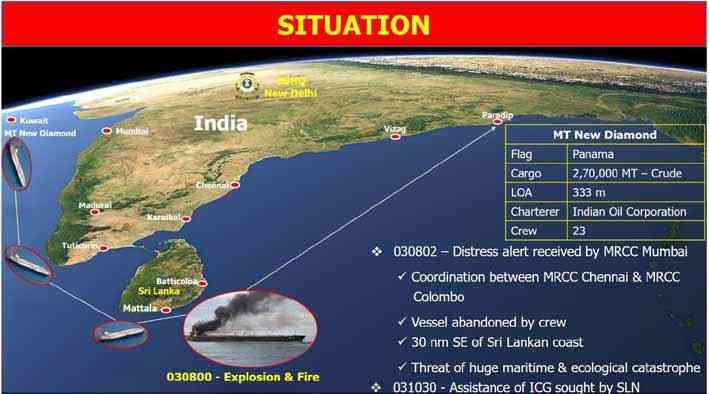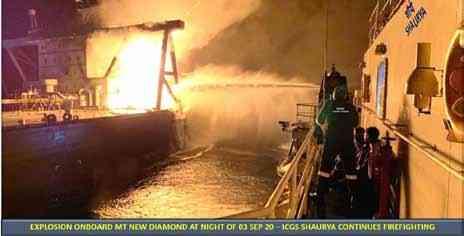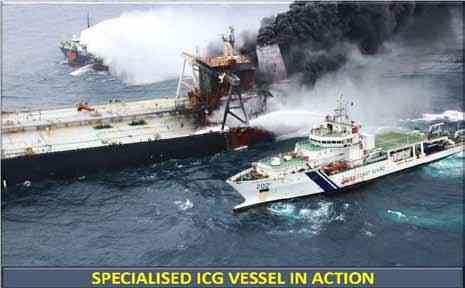
4 minute read
Indian Coast Guard for Securing Maritime Asset and life at Sea
Indian Coast Guard (ICG) created another maritime history by leading a major firefighting operation onboard Very Large Crude Carrier (VLCC) “MT New Diamond” wherein the entire highly inflammable cargo “Kuwait Export Crude” was protected despite raging fire and intermittent explosions.
ICG spearheaded a perilous firefighting operation over seven days, in dousing an intense fire onboard the 333 metre long Oil Tanker off Sri Lankan East Coast, carrying about Three lakh Metric Tons of crude oil {Cat 1 (inflammable liquid as per MSDS)}, thus averting a serious disaster in the region which otherwise would have threatened the bio diversified marine environment of Sri Lanka, Maldives and Southern India. Comparing with the recent oil-spill mishap of 1000 T Bunker Oil from MV Wakashio witnessed off Mauritius in Aug 2020 that led to declaration of “National Emergency” by the Island Nation, the quantum of crude in this incident was 270 times voluminous. It is left to imagination that how devastating an oil spill of this high magnitude would have been for the region. MT New Diamond, a Panama flagged vessel with 23 crew, was on passage from Kuwait to India (Paradip Port), reported fire due to boiler explosion aboard on the morning 3rd September 2020 about 40 NM (approx. 70 km) of Tirrukkovil (Southeast Sri Lankan Coast). The distress message was picked-up by Maritime Rescue Coordination Centre (MRCC), Colombo as also by MRCC Mumbai. Sri Lankan Government, post assessing the situation, requested immediate support of India through HCI in Sri Lanka. Indian Coast Guard is the authority for National Maritime Search & Rescue (NMSAR), National Coordinating authority for Oil Spill Response in Indian waters and Competent National Authority under the Regional South Asian Co-operative Environment Program (SACEP) for responding and coordinating Marine pollution response in South Asian Sea region. The SACEP Sri Lanka, sought assistance of ICG, as the
Advertisement

threat of Oil Spill to the entire region was imminent to conduct Rescue and Fire Fighting Operation on the ill-fated Tanker, including Pollution Response operation, India being a signatory to the Regional association mechanism.
A multi-mission capable Offshore Patrol Vessel ICGS Shaurya, on Preventive Deployment off Tamil Nadu coast immediately diverted and was the first ship to arrive at the “Golden Hour” on scene to commence firefighting by afternoon on same day.
The night of 03 Sep witnessed one more blast onboard Motor Tanker and ICGS Shaurya continued her effort to keep the fire under control. Meanwhile, a joint effort by 3 MRCC of ICG and Sri Lanka Navy had ensured rescue of 22 of the 23 crew by alerting nearest ships in vicinity. The timely and daring firefighting efforts by ICGS Shaurya was the game changer and ensured that the fire remain contained within the bridge and accommodation area. If not, the fire would have spread to the cargo hold carrying huge volume of crude, resulting in explosions and consequent catastrophic environmental disaster.
By 4th september, six ICG ships, including specialist Pollution Response





Vessel, augmented initial response and two Dornier aircraft were pressed in action to operate from Sri Lankan soils for Logistics & Pollution response. ICG Ships utilised sophisticated special-fit External Fire Fighting (EFF) system to spray foam compound for smothering the oil fire. In addition to ICG ships, Sri Lankan tugs Ravana, Vishaba and ALP Winger, also joined on that day and commenced firefighting.
While the collective firefighting was underway, the adrift distressed vessel was moving towards Sri Lanka coast due to the prevailing seasonal currents in area, posing an immediate threat of grounding and resultant oil spill once near depths of 20 metres. Indian Coast Guard boarding team, in a high risk operation braving the rough seas and adverse conditions, embarked the under fire unmanned tanker and successfully connected the tow to Sri Lankan Tug TTT-1 to pull it away from land and position favourably into the wind to prevent spread of fire to the forward section of the ship. This move was crucial in the operation that ensured saving cargo of the oil tanker and averting major oil spill in the region.
With intense and persistent firefighting attack for three days by ICG Ships along with Sri Lankan ships and tugs, coming within 50 metres of a potentially huge explosive seat, the fire got doused by 6th morning. ICG ships however continued to monitor the situation, in case of re-eruption due to prevalent temperature and undertook surface-boundary cooling to reduce it around the cargo holds.
As estimation of a likelihood of reoccurrence, a huge explosion again occurred on the starboard diesel oil tank on 6th afternoon and by midnight, huge flames reaching up to 60 metres height from the deck were seen at the rear part of the ship. All units scaled up from boundary cooling to firefighting and because of yet again sustained and close quarter efforts by four ICG Ships and two Sri Lankan and salvour tugs, the fire was completely doused again by 8th afternoon.
Notwithstanding, continuous boundary cooling with sea water was maintained to reduce temperature of the ship’s structure. As a result of two











